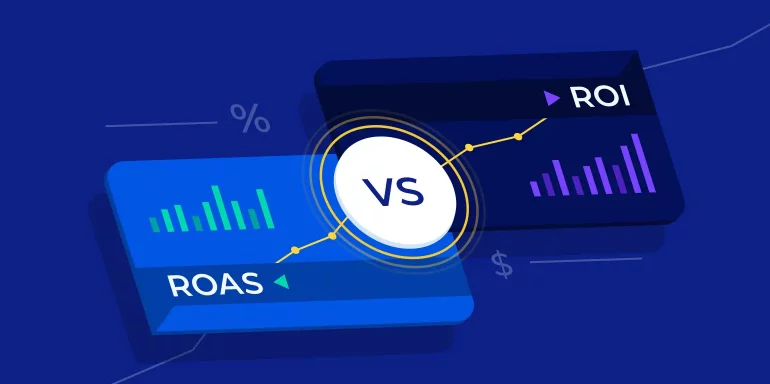Advertising ROI and ROAS are both important metrics—and are often used interchangeably. In fact, they are different in some important ways. Think of ROI as evaluating the strategy—it is a macro view of the ad campaign as it contributes to business profitability. ROAS is evaluating the tactic—it is a close-up view of ad campaign performance. Used together, ROI and ROAS give you a more complete picture of the effectiveness and profitability of your ad campaigns than either could alone.
Defining ROAS and ROI
Return on ad spend (ROAS) is a metric used to measure the total revenue generated per advertising dollar spent. It is calculated by dividing the campaign revenue by the campaign cost.

Return on investment (ROI), as applied to advertising, is the profit generated by the ads relative to the costs of the ads. The metric measures how ads contribute to a brand’s bottom line.

While ROAS measures gross revenue generated for every dollar spent on advertising, ROI accounts for the amount you earn after expenses.
How is each metric used?
ROAS and ROI are used to tell different parts of the marketing effectiveness story. ROI helps us understand whether the overall strategy is working and whether the campaign is worth the investment. In contrast, ROAS focuses more narrowly on the effectiveness of the ad campaign in isolation. ROI tells us whether the campaign is profitable, whereas ROAS tells us whether the ads effectively generate clicks, impressions, and sales revenue.
For example:
If a DTC shoe company spends $10,000 on a Facebook ad campaign that results in $50,000 in revenue, the ROAS is calculated as: $50,000 ÷ $10,000 = $5, or a ratio of 5:1. This metric enables us to compare and optimize performance across campaigns and platforms.
Assuming the DTC shoe company has a 15% margin, the ROI is calculated as ((($50,000 x 15%) – $10,000) ÷ $10,000) x 100 = -25%
Looking at both metrics together, we now see a complete picture. Whereas a 5:1 ROAS seems really good, it is actually generating a negative ROI because of the narrow margin. With a margin of 15%, we would need a 7:1 ROAS for the campaign to be profitable.
What’s the best way to analyze overall campaign performance?
ROI is great for understanding the overall business value of a campaign, but it doesn’t give us granular insight into campaign performance. ROAS does a better job of that, but to get a more dimensional picture of overall campaign performance, we need to look at the cost of generating the customer lead. This is where cost per action (CPA) or cost per lead (CPL) comes in. CPA and CPL (which is a type of CPA used for lead-gen campaigns) are calculated as the total ad costs divided by the number of conversions.
CPA is useful for measuring the effectiveness of campaigns focused on conversions, but that may not immediately result in sales. It is also useful for analyzing cross-platform campaigns.
Need help getting started?
We know how hard it can be to start optimizing your ad campaigns and landing page conversions. Instapage can help. We offer three different plans to help take the stress out of building, optimizing, and converting—helping you create better landing pages and see better results. Sign up for an Instapage 14-day free trial today.

Try the world's most advanced landing page platform with a risk-free trial.
